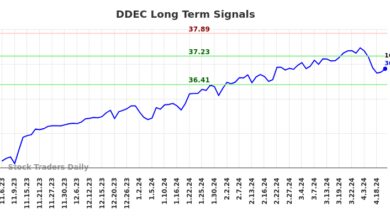Trading Lesson: Buying The Dip 101

Buy on the dip
getty
Over the past five years, the Spyder Trust (SPYPYSPY) has recorded four double-digit yearly gains. The gain of 26.20% in 2023 was only surpassed by the 31.22% gain in 2019. During my decades in the markets, it is my view that a higher portion of investors are now underperforming the yearly gains by a wider range.
In my view, this result is due in part to the 24-hour news cycle and a financial press that attempts to provide exciting programming by switching between a boom or bust scenario even during the same day. The pro-recession drumbeat throughout most of 2023 likely contributed to many investors staying on the sidelines.
From a technical or charting perspective, there are always pauses or interruptions in both strong up or downtrends. These pauses can take several different formations and are often referred to as continuation patterns. They are one of my favorites.
These pauses in the major or dominant trend often cause a change in sentiment. In a strong uptrend, those who went long when the bullish sentiment was too high often paid too much as they may have bought above the starc+ band. Some also use too wide a stop and are either stopped on the stronger-than-expected decline or they sell in a panic after the losses mount.
In this week’s trading lesson, I will be looking at some of the strategies that I use to identify the price levels where one should be buying the dips while still controlling the risk.
The key to buying a dip in an ongoing uptrend or selling a rally in a declining market is to identify a good level of support or resistance as well as a stop level. One of my favored methods is to look for a price drop back to the vicinity of the rising 20-day EMA to buy, or rallies back towards the declining 20-day EMA to sell.
Looking at the spread between the 20-period EMA and the closing price is what I call the EMA Osc. I have also found the weekly 20-period EMA to be a useful method for identifying major support or resistance.
Costco (COST) – Daily
Tom Aspray – Viper Report.com
Costco (COST) has been a stellar performer since the start of November up 33%. The resistance at $562.86, line a, was overcome on November 10th. Two days later it moved above the starc+ band, point c, as it closed at $585.69. This indicated it was in a high-risk buy area and it was also 5% above the 20-day EMA at $555.37.
The on-balance-volume (OBV) moved above its resistance indicating a change in trend. The next day it had a low of $558.70 (point d) and the following day dropped to $560.47. Both lows were less than 1.5% above the 20-day EMA. A stop under the November 9th low of $548.71 would have had a risk of 2.3%. As I teach my students I try not to risk more than 5% on any one position as adjusting the stop as the trend continues is critical.
The rally over the next five days took COST back to the prior high. It was followed by a three-day pullback to $569.02 (point e) which was again close to the rising 20-day EMA at $567. This was another potential entry point. By December 13th COST surged above its daily starc+ and eventually reached $665.77.
Over the next eleven days COST corrected about 5% as it had a low of $639.58 (point f) that was just above the still-rising 20-day EMA at $536.70. Once the rally resumed then a stop under the low was reasonable. It just took COST another two weeks to reach a new high of $697.63.
Four days later there was another potential entry at point g, as the low of $674.97 was just 0.6% above the 20-day EMA. The length of the rally is also a consideration in terms of risk control as since COST has been moving higher for four months, the bullish sentiment is high and the risk of a decline is higher.
My approach is to use several, uncorrelated methods to determine not only the market’s trend but also the key support and resistance levels where the probabilities favor establishing or exiting a position.
Microsoft (MSFT)
Tom aspray -ViperReport.com
MicrosoftMSFT Corp. (MSFT) bottomed in early October when it broke its downtrend, line a, and moved above its 20-day EMA that was turning higher. The 20-day EMA was tested several times during the next week as MSFT traded between $325 and $330. There was a one-day surge to the daily starc+ band but quickly pulled back. MSFT started off November above the monthly pivot (in blue) which was calculated using the price range from October.
By the middle of the month, the initial monthly resistance (R1 in red) at $351.08 was overcome. There were no signs that the rally was losing momentum as the 20-day EMA was rising strongly. MSFT rallied to a high of $383.59 before the end of the month.
In December, MSFT traded in a narrow range above and below the pivot and the flat 20-day EMA. There was only one day that it closed well below its EMA. Two days later the OBV broke out to the upside, line e, which was a sign of new buying.
At the start of January, MSFT dropped below the new pivot but held well above the early December low at $362.23. The strong close at $383.06 on January 10th reasserted the uptrend as the OBV moved sharply higher. On February 9th MSFT closed above the R1 at $418.99. Two days later it dropped to close at $405.57 as the OBV closed below its WMA.
In Part 2 on Buying The Dip, I will discuss how Fibonacci analysis and chart targets can be used to identify buy and sell levels for both dip buyers and sellers. These techniques can be used in either up or down markets.
I am planning a series of new Trading Lessons in 2024 so if there is a topic you would like to have me discuss, email me at Tom@ViperReport.com with the Topic in the subject line.




